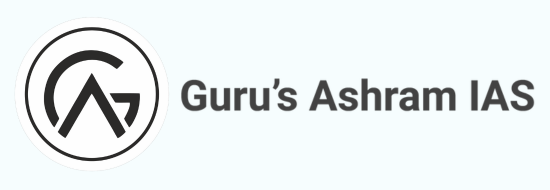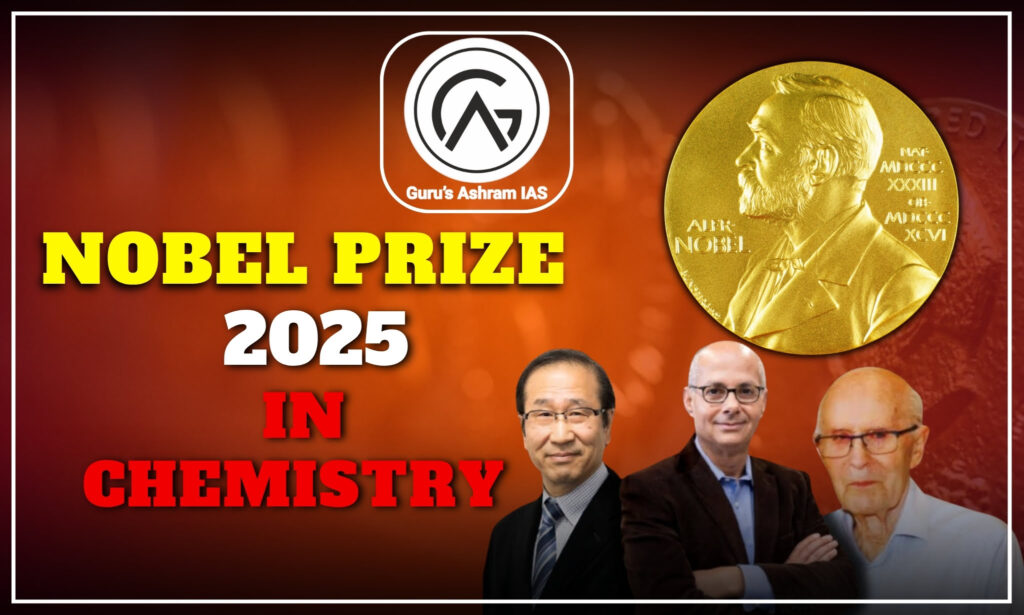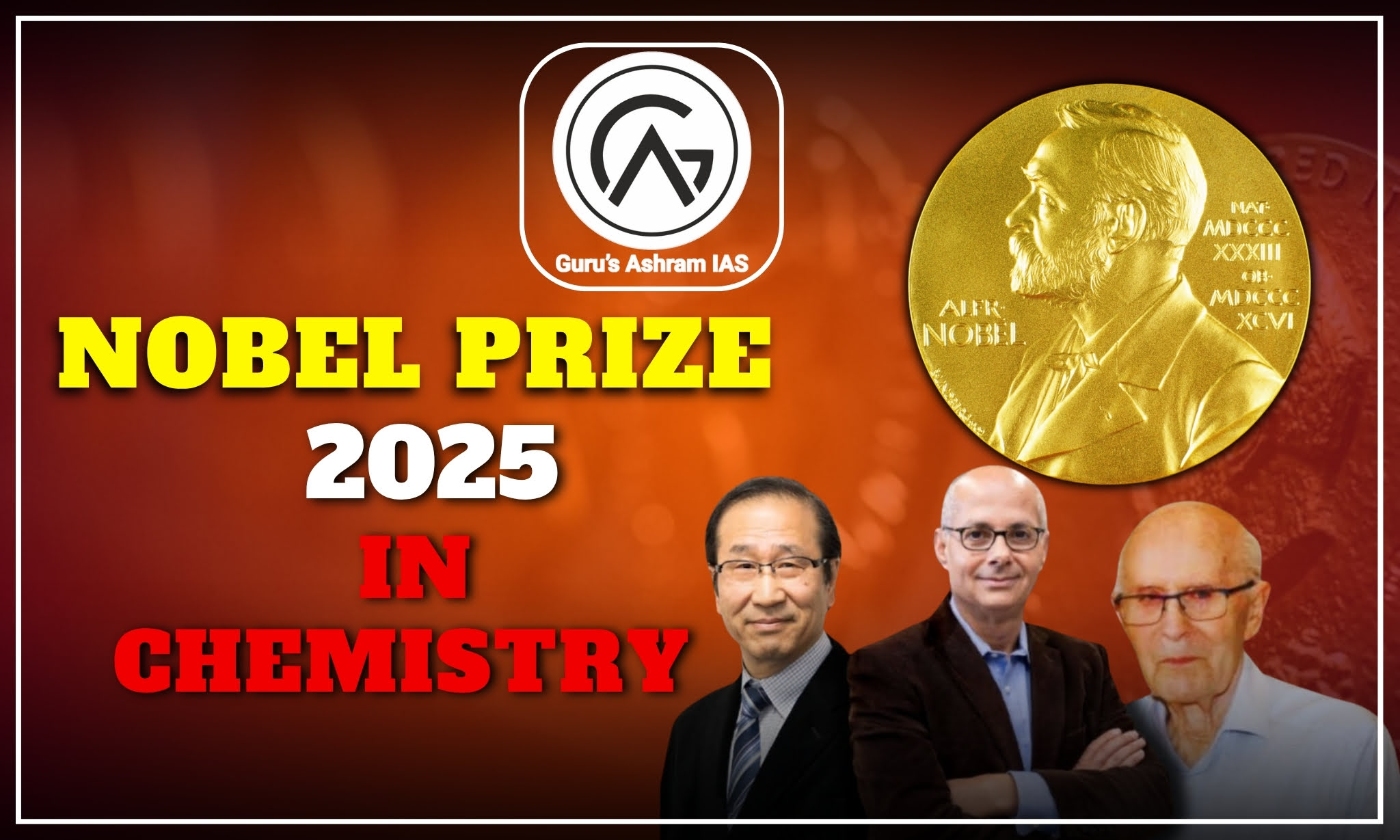Nobel Prize in Chemistry 2025
The Royal Swedish Academy of Sciences has awarded the Nobel Prize in Chemistry 2025 to Susumu Kitagawa (Japan), Richard Robson (Australia), and Omar Yaghi (USA) for their groundbreaking contributions to the field of Metal-Organic Frameworks (MOFs). This prize highlights revolutionary discoveries in chemistry and their significant impact on addressing global challenges related to the environment, energy, and climate change. The Nobel Prize in Chemistry 2025 Winner List features these three scientists, as detailed in the official announcement and Nobel Prize in Chemistry 2025 from the Nobel Foundation.
Key Highlights of the 2025 Nobel Prize in Chemistry
Development of Metal-Organic Frameworks (MOFs):
Richard Robson:
- One of the first scientists to create 3D porous structures by combining metal ions (e.g., copper) with organic molecules.
- His work laid the foundation for porous materials with large voids capable of trapping molecules.
Susumu Kitagawa:
- Advanced Robson’s research by demonstrating that MOFs can be stable and have the ability to expand or contract based on environmental gases or chemicals.
- This discovery has proven critical for gas capture (e.g., CO2) and energy storage.
Omar Yaghi:
- Coined the term MOFs and developed reticular chemistry, a process of systematically combining metal ions and organic molecules to create crystalline structures.
- His work enabled the rational design of MOFs for specific properties.
Structure and Properties of MOFs:
- MOFs are crystalline materials forming sponge-like porous frameworks made of metal ions and organic molecules.
- They contain small, well-organized pores capable of trapping, storing, or filtering gases and chemicals.
- Their adaptable structure allows for customization for specific chemical processes.
Significance of MOFs:
Water Harvesting:
- MOFs can extract moisture from the air in desert regions, addressing water scarcity.
- This is significant for water-stressed regions like India, where water management is a key policy issue.
Carbon Capture:
- MOFs can effectively store carbon dioxide, aiding in combating climate change and supporting India’s net-zero emission goals (2070).
- This is relevant to environmental sustainability and Carbon Capture and Storage (CCS) technologies.
Storage of Toxic Gases:
- MOFs can safely capture and store harmful chemicals, critical for industrial safety and environmental protection.
Specific Chemical Processes:
- The adaptability of MOFs makes them useful in drug manufacturing, energy storage, and catalytic processes.
- This is relevant to India’s progress in renewable energy and industrial innovation.
Indian Contributions to Chemistry: Historical Perspective
Venkatraman Ramakrishnan (2009):
- Indian-born scientist awarded the 2009 Nobel Prize in Chemistry, alongside Thomas A. Steitz and Ada E. Yonath, for research on the structure and function of ribosomes.
- His work is significant in biochemistry and medicine, particularly in antibiotic development.
Potential Questions for Main Examination:
Question 1: How have Metal-Organic Frameworks (MOFs) demonstrated the potential to revolutionize the environment and energy sectors? Evaluate their applications in the context of India’s climate and water crisis. (250 words)
Question 2: Explain the role of chemistry in addressing climate change. Discuss the contributions of Metal-Organic Frameworks (MOFs) in the context of India’s environmental policies. (250 words)
Potential Essay Questions:
Question 1: Science and Sustainable Development: Addressing Global Challenges
Question 2: India’s Scientific Renaissance: Contributions and Challenges on the Global Stage
Question 3: Scientific Innovation and Human Welfare: Contributions to Environment and Health
Potential Questions for Preliminary Examination:
Question 1: The 2025 Nobel Prize in Chemistry was awarded to:
- A) John B. Goodenough, Stanley Whittingham, and Akira Yoshino
B) Susumu Kitagawa, Richard Robson, and Omar Yaghi
C) Venkatraman Ramakrishnan, Thomas A. Steitz, and Ada E. Yonath
D) Jennifer Doudna and Emmanuelle Charpentier
Answer: B) Susumu Kitagawa, Richard Robson, and Omar Yaghi
Question 2: Consider the following statements regarding Metal-Organic Frameworks (MOFs):
- MOFs are crystalline materials made of metal ions and organic molecules.
- They can be used for carbon dioxide capture and water harvesting.
Which of the following is correct?
- A) Only 1
B) Only 2
C) Both 1 and 2
D) Neither 1 nor 2
Answer: C) Both 1 and 2
Question 3: The only Indian-origin scientist awarded the Nobel Prize in Chemistry is:
- A) C.V. Raman
B) Venkatraman Ramakrishnan
C) Har Gobind Khorana
D) Amartya Sen
Answer: B) Venkatraman Ramakrishnan
Question 4: Reticular chemistry, associated with the 2025 Nobel Prize in Chemistry, was developed by:
- A) Susumu Kitagawa
B) Omar Yaghi
C) Richard Robson
D) None of the above
Answer: B) Omar Yaghi
Question 5: Metal-Organic Frameworks (MOFs) are not used in which of the following areas?
- A) Water harvesting
B) Carbon dioxide capture
C) Nuclear reactor design
D) Storage of toxic gases
Answer: C) Nuclear reactor design





